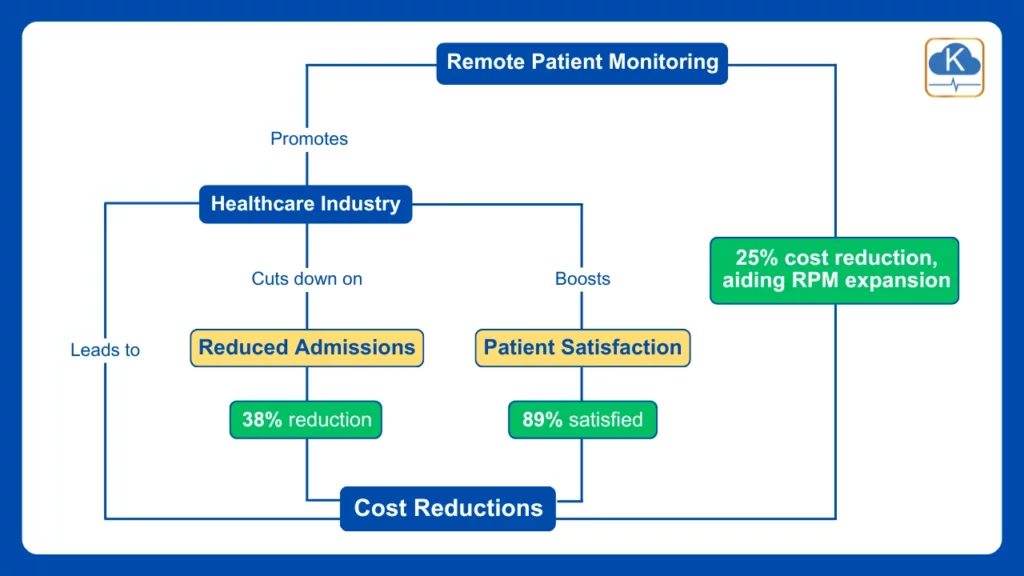Remote Patient Monitoring (RPM) is transforming chronic disease management programs by enabling early detection and intervention, which are essential for preventing severe health complications. Most healthcare professionals recognize the necessity of timely medical responses to reduce hospitalizations and enhance patient outcomes.
In this blog, we will explore how integrating RPM with disease management programs (DM program) acts as a crucial preventive tool in healthcare. We’ll uncover effective strategies that showcase RPM’s effectiveness in catching early signs of complications, emphasizing its role in reducing healthcare costs and improving the quality of patient care.
What is RPM’s Role in Chronic Disease Management?
Chronic diseases, such as diabetes, heart disease, and chronic respiratory conditions, require ongoing management due to their persistent and evolving nature. These diseases often challenge healthcare systems with their complex needs, including continuous monitoring and long-term treatment strategies.
Integration of RPM in Disease Management
- Continuous Monitoring: RPM devices continuously track vital health metrics such as blood sugar levels, blood pressure, and heart rate, allowing for constant observation without the need for a hospital stay.
- Data Collection and Analysis: These systems gather vast amounts of health data over time, which are analyzed using advanced algorithms to detect any deviations that might indicate potential health risks or exacerbations.
Benefits of RPM with a DM Program
- Proactive Care: By integrating RPM with comprehensive DM programs, healthcare providers can proactively and effectively manage patients’ conditions. RPM alerts healthcare professionals about critical changes in a patient’s condition, enabling early intervention before a severe exacerbation occurs.
- Customized Treatment Plans: Continuous data provided by RPM allows for more tailored treatment plans based on the patient’s current health status, improving the overall effectiveness of the management strategy.
| Health Metric Monitored | Benefit of RPM |
|---|---|
| Blood Pressure | Early detection of potential hypertension episodes, allowing for immediate adjustment of medications. |
| Glucose Levels | Continuous glucose monitoring helps in fine-tuning diabetes management and preventing spikes. |
| Heart Rate | Identifies irregular heartbeats or arrhythmias early, potentially preventing serious cardiac conditions. |
Table: Impact of RPM on Chronic Disease Management
RPM, when combined with a well-structured DM program, significantly enhances the management of chronic diseases. It not only supports early detection of potential health issues, but also allows for the dynamic tailoring of treatment plans to suit individual patient needs, leading to better health outcomes and more efficient use of healthcare resources.
Preventive Benefits of RPM
Chronic diseases often progress silently, with symptoms escalating only when complications arise. RPM disrupts this pattern by enabling continuous monitoring, a critical factor in preventing severe complications through early medical intervention.
Early Intervention = Reduced Complications
RPM empowers proactive chronic disease management through continuous monitoring and early intervention. This translates to:
- Preventing Complications: RPM allows real-time tracking of vital signs. For example, early detection of heart failure signs in patients with heart conditions allows for prompt treatment adjustments, preventing worsening.
- Reduced Hospitalizations: A 2020 study by the Veterans Health Administration (VHA) published in the Journal of the American Medical Association (JAMA) Internal Medicine showed a 25% reduction in bed days and a 19% decrease in hospital admissions for chronic disease patients using RPM.
Key Features of RPM Technology
- Real-time Data Analysis: Advanced analytics identify trends that might indicate a decline in a patient’s health.
- Alerts: Customizable alerts notify healthcare providers and patients of critical changes in health metrics.
These features enable immediate attention to potential issues and enhance overall chronic disease management, leading to better patient outcomes and potentially lower healthcare costs.
Enhancing Patient Engagement and Compliance
Beyond preventing complications, RPM offers significant benefits for patient engagement and adherence to treatment plans. Here’s how:
- Active Role in Health Management: RPM equips patients with tools to actively participate in their healthcare journey. They can monitor vital signs, track trends, and gain insights into their health status. This empowers them to ask informed questions, make informed decisions, and feel more in control of their well-being.
- Psychological and Practical Benefits of Monitoring and Support: Continuous monitoring through RPM systems offers patients with chronic conditions security and peace of mind, as real-time data demonstrates the effects of lifestyle changes or medications, boosting motivation. Timely alerts and reminders also help ensure patients adhere to their treatment plans by preventing missed medication doses and important health checks.
By fostering patient engagement and empowering informed decision-making, RPM contributes to improved chronic disease management and potentially better long-term health outcomes.
Economic Impact of RPM on Healthcare Systems
RPM shines not only in improving patient outcomes but also in its cost-effectiveness for healthcare systems. Here’s why:
- Prevention vs. Reaction: Reactive care, relying on hospital admissions to address complications, is expensive. RPM’s preventive approach allows for early intervention, minimizing the need for costly in-patient care and potential complications.
- Reduced Healthcare Costs: Studies demonstrate significant cost savings associated with RPM. A 2017 Deloitte Center for Health Solutions report estimates that RPM can cut hospitalization rates by 17% and emergency department visits by 15%, leading to substantial cost reductions in chronic disease management.
By preventing complications and reducing reliance on expensive in-patient care, RPM offers a compelling economic argument for its integration into chronic disease management programs.

This diagram showcases the multi-faceted economic impact of RPM within the healthcare industry. It highlights the connection between RPM and significant outcomes such as cost reductions, enhanced patient satisfaction, and reduced admissions. These factors collectively support the expansion of RPM technologies, demonstrating their growing importance in modern healthcare systems. Data extracted and adapted from the Gitnux Marketdata Report 2024.
Challenges and Considerations in Implementing RPM
Implementing RPM systems involves navigating various challenges that can impact their effectiveness and acceptance. These challenges range from technological adoption barriers to concerns about data privacy and patient engagement. Understanding these obstacles and strategizing ways to overcome them is crucial for maximizing the benefits of RPM in preventive care.
| Challenges | Solutions |
|---|---|
| Technology Adoption | Offer training programs for both patients and healthcare providers to ensure ease of use and familiarity with RPM technologies. |
| Data Privacy Issues | Implement robust encryption methods and comply with healthcare regulations such as HIPAA to protect patient data. |
| Patient Acceptance | Enhance patient engagement through education about the benefits of RPM, and personalize the monitoring to suit individual patient needs and preferences. |
Table: Challenges and Solutions in RPM Implementation
DrKumo: Pioneering RPM Solutions Transforming Preventive Care in Chronic Disease Management
DrKumo is at the forefront of transforming preventive care in chronic disease management through its cutting-edge RRPM solutions. By enabling patients to monitor their health conditions from home in real-time, DrKumo’s RPM technology empowers proactive healthcare interventions, mitigating risks, and optimizing patient outcomes.
Through seamless data transmission and analysis, healthcare providers can deliver personalized care promptly, fostering a proactive approach to managing chronic conditions. DrKumo’s innovative approach not only enhances patient engagement but also reduces healthcare costs and prevents avoidable hospitalizations, ultimately revolutionizing preventive care in chronic disease management.
Takeaways
The integration of RPM into preventive care strategies for chronic disease management represents a significant advancement in healthcare. By enabling proactive monitoring and timely interventions, RPM solutions, such as those offered by DrKumo, empower patients to take control of their health while reducing the burden on healthcare systems.
Healthcare providers are urged to embrace RPM technologies to enhance early detection, reduce hospitalizations, and ultimately improve outcomes in chronic disease management, ushering in a new era of patient-centric care.
Ready to revolutionize your approach to chronic disease management? Contact DrKumo today to explore how our cutting-edge Remote Patient Monitoring solutions can empower your practice with proactive, patient-centric care. Take the first step towards improved outcomes and enhanced patient engagement by reaching out to us now.











